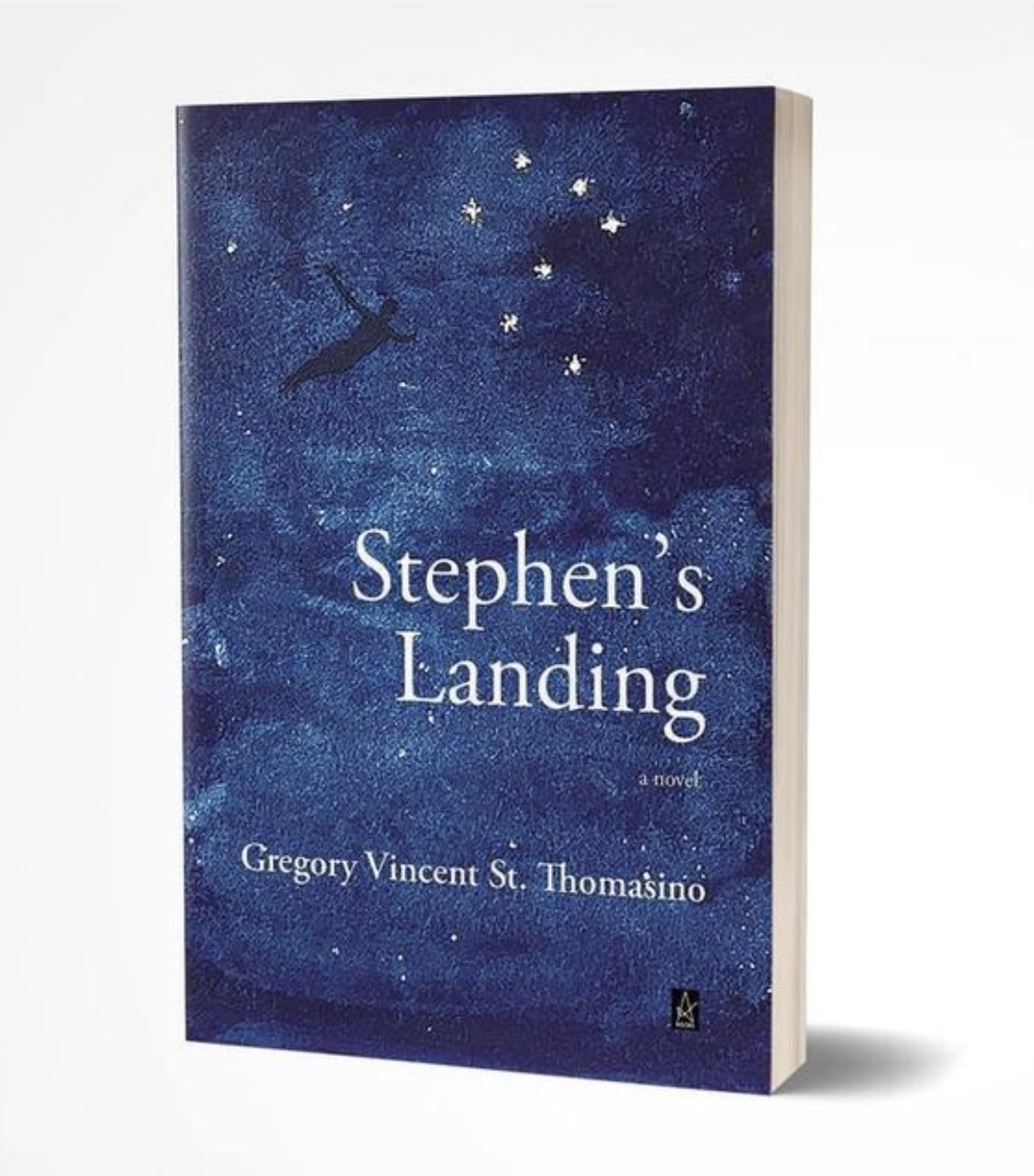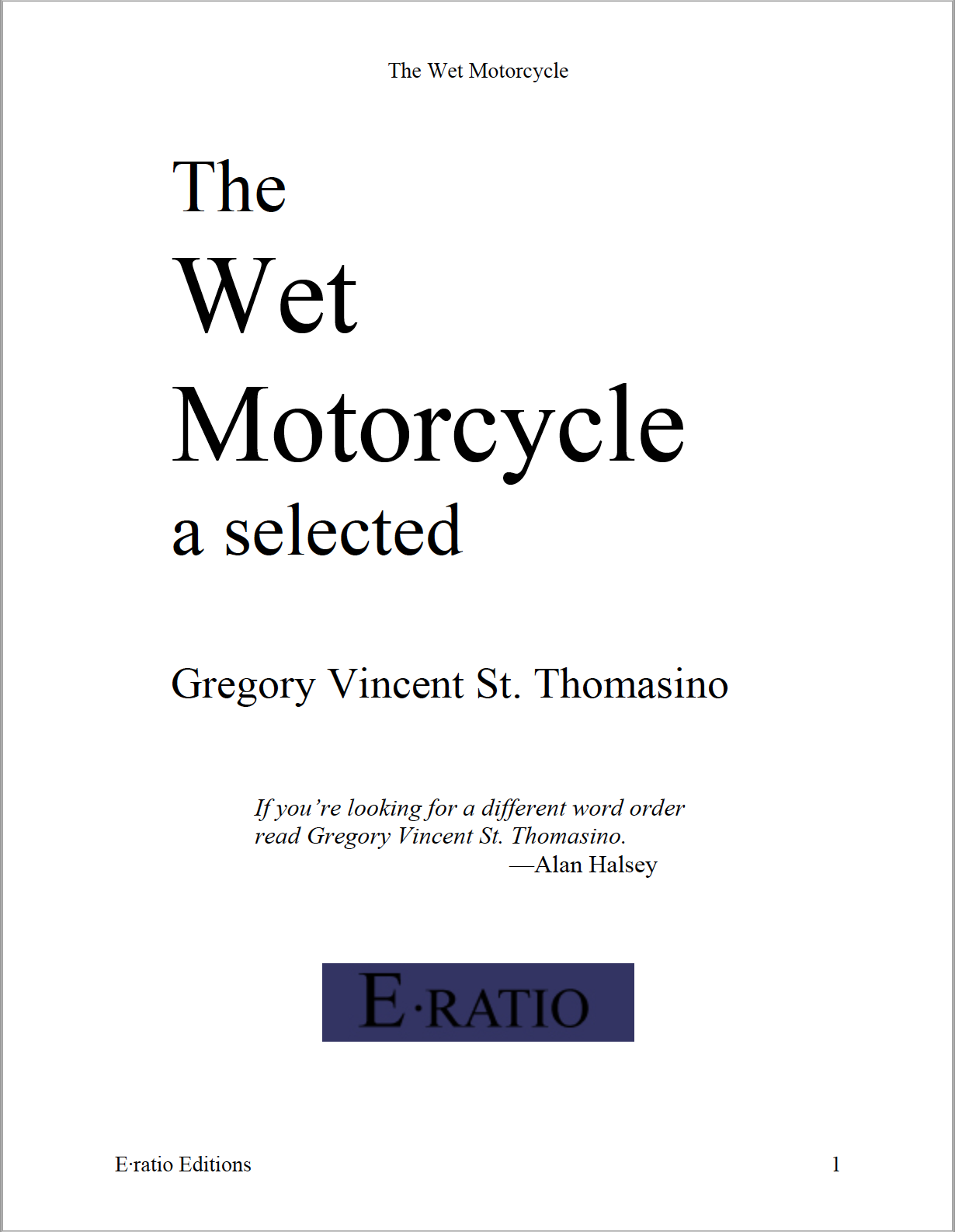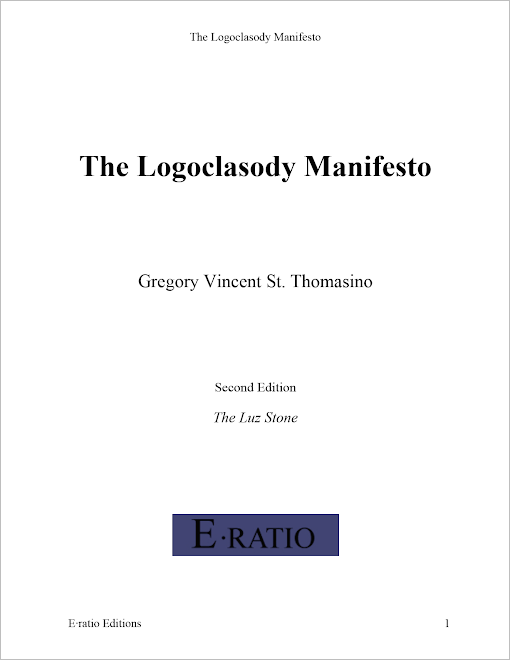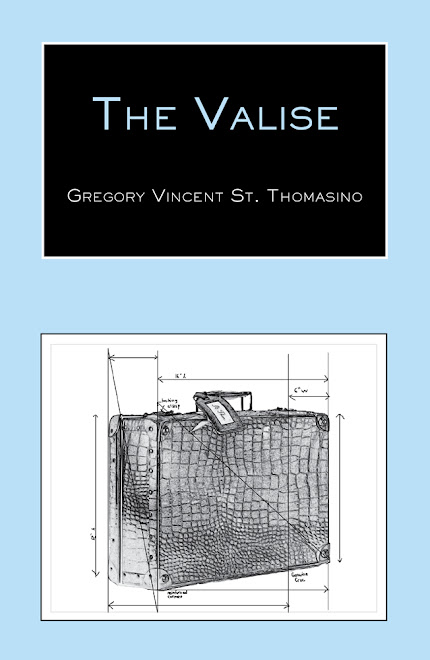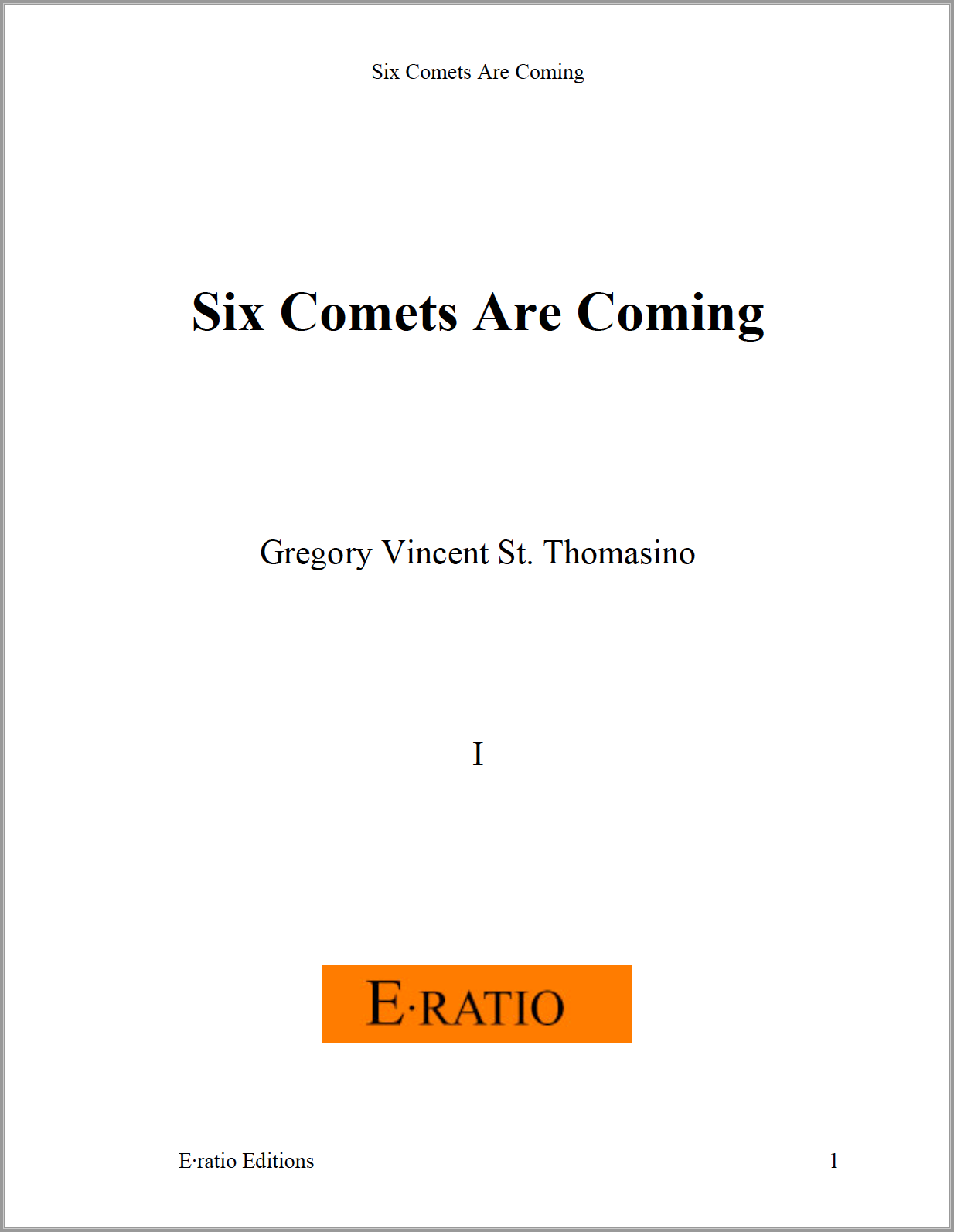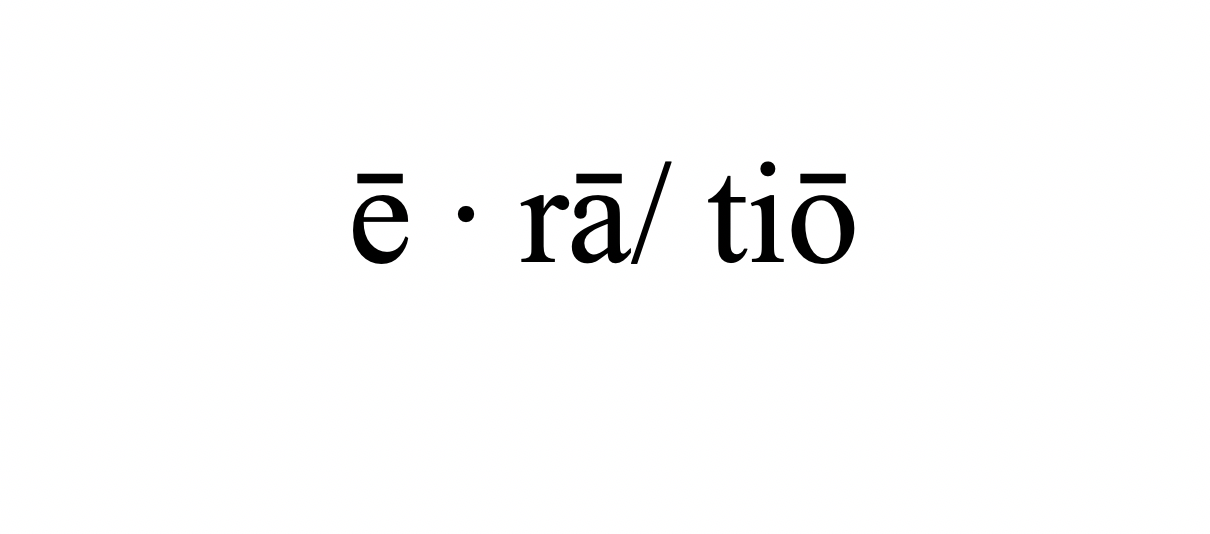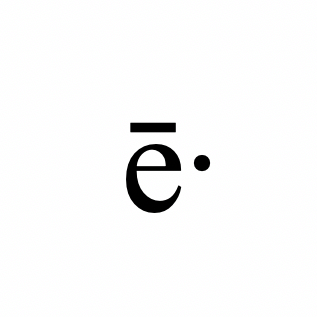Sunday, December 19, 2010
Monday, December 13, 2010
Monday, November 29, 2010
“Papier collé pipe et bouteille” (pasted paper pipe and bottle) by Picasso.
271 of the master’s creations turn up in France.
e·
Saturday, November 27, 2010
Edward Gorey’s covers for The American Puritans and The American Transcendentalists both edited by Perry Miller. On The American Puritans, see the steeple in the background. And notice Gorey’s initials, bottom right-hand corner, above the rock at two-o’clock. He doesn’t always “sign” his covers.
Companionables.
e·
Monday, November 01, 2010
a noun sing 4 new e·chaps from e·ratio editions
#10. The Galloping Man and five other poems by Gregory Vincent St. Thomasino. “ . . . how does / a body know, here is a hand, and here, is a sentence / or, / what’s riding on hearts . . . ”
#9. Prosaic Suburban Commercial by Keith Higginbotham. Two poetic sequences. “ . . . bathe deep in / the barely-there / disassembled gallery / of the everyday . . . ”
#8. Polylogue by Carey Scott Wilkerson. Poems. “ . . . with rules and constitutive games, / with paints and gramarye / with some modicum / of my reckless trust . . . ”
#7. Bashō’s Phonebook. 30 translations by Travis Macdonald. The great Japanese haiku poet Matsuo Bashō goes digital. Conceptual poetry. With translator’s notes.
E·ratio Editions
.pdf (free)

e·
#10. The Galloping Man and five other poems by Gregory Vincent St. Thomasino. “ . . . how does / a body know, here is a hand, and here, is a sentence / or, / what’s riding on hearts . . . ”
#9. Prosaic Suburban Commercial by Keith Higginbotham. Two poetic sequences. “ . . . bathe deep in / the barely-there / disassembled gallery / of the everyday . . . ”
#8. Polylogue by Carey Scott Wilkerson. Poems. “ . . . with rules and constitutive games, / with paints and gramarye / with some modicum / of my reckless trust . . . ”
#7. Bashō’s Phonebook. 30 translations by Travis Macdonald. The great Japanese haiku poet Matsuo Bashō goes digital. Conceptual poetry. With translator’s notes.
E·ratio Editions
.pdf (free)

e·
Friday, October 29, 2010
MYSTERIOSOS AND OTHER POEMS
by Michael McClure
“Michael stands on my back / growing wrinkles”
— Michael McClure, Plum Stones: Cartoons of No Heaven
“I’m an old man made of wheels of spinning flesh”
— Michael McClure, Mysteriosos
To read a Michael McClure poem is to bring ourselves back to something; it isn’t so much a specific recollection as it is a reminder of something we may have forgotten. “I AM AWED / by her demon face,” he writes of someone he calls “the secretary of deceit.” The tone here is political, ironic and momentarily judgmental. (He will later insist that he himself may be as bad: his own “trembling spirit is capable of everything”: “I will kill, torture, and maim Palestine / and tease it with fire.”) But the word “awed” is important, and it is to be distinguished from the context of “shock and awe”: “awe” — astonishment — is at the heart of this amazing septuagenarian’s work:
THE
ELEPHANT
CHARGES,
shrieking in rage,
and our aged guide,
the Anglo-Indian colonel,
shakes one finger
out the car window.
“Stop!”
he shouts to his “old friend”
and she does
and she stares
short-sightedly
from wrinkled eye bags
AND
SHE
TURNS
AWAY
from us,
then swings back
and bellows
her jaw-shaking trumpet blast,
and shuffles
away sideways
into the swinging branches.
McClure’s world is a constantly astonishing place — a place full of, to use the title of this book, “mysteriosos.” “Myserioso” = “having a mysterious nature or quality; enigmatic; inexplicable.” It is usually used as an adjective or adverb but may also be used as a noun. McClure is thinking of the term specifically in connection with Thelonious Monk, the great, constantly questioning jazz pianist who released an LP, Misterioso, in 1958; the cover of Monk’s LP is a painting by the Italian Surrealist Giorgio De Chirico: The Seer, or The Prophet. McClure makes no such specific claim for himself — “I still long to be Shelley,” he sighs at one point — but he insists that his poetry “demands the tearing down of what we are and letting our energies and bodies of meat and nothingness rebuild themselves.” This biospiritual process happens over and over again but never in a straightforward, “logical” way: “NO MATTER — ANTI-MATTER — DARK ENERGY”; it too is “mysterioso.”
At 78 McClure is neither resting on his laurels nor kvetching about the loss of his powers. Mysteriosos is as challenging and demanding a book as he has ever produced. But differences can be noted. I wrote this about his extraordinary 1970 book, Star, which McClure himself described as “a blast of my poor brain splattered over Hell and Earth & Heaven”:
Star enunciates a moving consciousness which is constantly thrust towards both intellect and the flesh and which dizzyingly but illogically perceives intellect and the flesh to be simultaneously identical and painfully split apart. McClure frequently quotes with approval Mallarmé’s statement that poetry is the language of a state of crisis. The crisis of Star is that the very conditions of thought and utterance are constantly at war with each other, constantly generating the most painful of oppositions — and yet silence is not even a remote possibility: speech is the poet’s only salvation . . . Jean Harlow and Billy the Kid are less “characters” than they are huge metaphors, almost Blakean figures, by which McClure can express his constantly shifting ambivalence.
Here, in this book of “the truth of shifting / complexities,” McClure says, “Old age or childhood, it is all renewable, / reversible, delivered with a warranty / that nothing is there in the nothingness”; “I am a flowering.” Sounding a little like John Donne, he writes, “My mouth / with your nipple in it / is the rising of thought.” McClure’s vision is essentially the same as the one he had forty years ago — “Knowing in all possible directions”! — but it is considerably calmer these days. It is as if the Harlow figure who haunted his young manhood with its “SEXUAL ADDICTION” has “morphed” — the word is an important one in this book — into the apparition he calls “Dear Being”:
WHAT I HAVE GIVEN MYSELF
is this love, invented for you.
The phrase refers specifically to the poet’s wife, Amy Evans McClure, but it extends beyond that to a feeling of acceptance and love for the whole of the universe:
WE HAVE THE JOY OF HERETICS
By simply being here, drinking from footsteps.
No pleasure, no shame, no guilt, just as life is . . .
WE DID NOT CHOOSE IT — WE ARE HERE . . .
PERFECT. Perfect. Perfect blotches
Hanging together in undreamed causeless systems.
No time anywhere — like smears on fingers.
Inspiration changes tiny strings to thick
Frequencies of matter. Hear the clatter
Of a megatherium family by the water hole.
These lines are taken from a remarkable long poem, “Double Moire for Francis Crick” — the discoverer of the structure of the DNA molecule and a longtime friend of McClure’s who lay dying as the poem was being written. The poem, which Crick never saw, begins with a moving reference to the endurance of “the MiddleWay” of Buddhism and to the possibility of the new — of liberation — even at such a moment:
THE CHANTING IN TIBET HAS NOT CEASED
— IT IS AS IMMORTAL AS MEAT —
it sings of the Middle Way.
Put out the fires in the eye
there is another style besides hatred and heat.
Let the soul go, build a pliant strong heart . . .
nowhere to go but
halfway to freedom. . . .
The most remarkable stylistic device of Mysteriosos is probably rooted in what McClure refers to as his explorations into “buddhist hua yen thought.” (Garma C.C. Chang’s The Buddhist Teaching of Totality: The Philosophy of Hwa Yen Buddhism is one of the poet’s favorite books.) According to hua yen Buddhism, an individual entity is not limited to an individual point of view. Every thing includes the whole — includes Everything. Hua yen asserts the mutual containment and “interpenetration” of all phenomena: one thing contains all things that exist.
McClure tells us explicitly that the poems of the “Dear Being” sequence are “born from earlier books, repeating opening lines of poems to begin new poems” and that in “Double Moire for Francis Crick” he “worked with an earlier poem . . . titled ‘Moire’ and used each line to begin a stanza in the new enlarged poem”: “Like an organism, ‘Double Moire’ began to be free in time and place, and to exist in the oneness of everything.” What he doesn’t tell us is the extent to which these poems constantly repeat lines, phrases, words as they “morph” from one poem into another — as aspects of separate poems interpenetrate one another.
I
T
I
S
all
QUICK
!!!
on page 35, for example, shows up as
It is all
QUICK
in a quite different poem on page 65. Similarly, “Mist and a star in his antlers” on page 40 shows up as “MIST AND A STAR IN MY ANTLERS” on page 60. Indeed, the word “antlers” may be a morphing of the word “anthers” on page 44. If everything is everything, if all things interpenetrate, then the poems themselves cease to be self-contained, individual entities: words and phrases from one poem might just as easily be a part of another poem. Life repeats itself in various configurations — all simultaneously moving together and apart, all “QUICK.” This, in a way, is McClure’s version of what Jack Spicer named “the serial poem” and which Jack Kerouac practiced in Mexico City Blues — a primary text for McClure.
A poet born in 1932 might well dwell upon his memories and his — to use a word that shows up prominently in this book — “gone” friends. There are some wonderfully elegiac passages in Mysteriosos as McClure recalls some of the famous poets who have been his companions:
I’m
introduced, “Michael, this is Robinson Jeffers . . . ”
And I mumble something.
In his salon among
walls of books in wooden apple crates, and pastels
of Morris Graves, Kenneth Rexroth reads
a new poem in a nasal, grating voice.
With crossed eyes, and hair alight
with genius, Robert Duncan sings songs from his Faust Foutou [sic].
It is exactly like the play of the dark, pouncing weasel
in the abandoned corral under the buckeye trees,
or Kenneth Patchen’s bulging eyes looking down at the waves of the Bay
where seals haul up on the mud to sleep beside traffic.
McClure does not deny his age or his aging (Mysteriosos has beautiful elegies to Philip Whalen, Robert Creeley, Philip Lamantia), yet the central message of the book is not elegy but the sheer aliveness, the wonderful, dizzying, endlessly interesting, “myriad” complexity of life itself:
AMINO TRIGGERS IN SPACE: in ponds
on ripples, and among the moons of Saturn.
Everything burns for the eyes that will
come into being. The twisting shapes
are hunting their forms, the big ones
grow and shrink and in themselves are the answers.
WE ARE ACTIVITY. . . .
Surprisingly to some perhaps, love and marriage are primary themes of this book — though, speaking of marriage, McClure remarked on my radio show that people are afraid to say I love you, “and they’re probably right: if people aren’t inventing love, they shouldn’t talk about it. Love has to be invented. It’s not a ghost that floats around in the air that you snap up when you get married or something. It’s part of soul making.” As always in McClure, you make your life: it isn’t something that’s simply given.
One of the most beautiful small poems in Mysteriosos is an “Epithalamium” the poet wrote for my son Sean and Sean’s bride Kerry Hoke. I’ll end this piece with that sweet, short, active poem, in which — as with all the poems in this wonderful book — the universe makes itself known in no uncertain terms:
PLUMB LIVES FROM MOMENT
to hour;
carve lives from week
to year.
Plume the spines with touches
and smiles;
o
b
e
y
your hearts
in whirlpool of foment.
It’s time to be growing
crowns on your heads.
Erase lines from nightly beds.
It all happens
with sun and with stars.
Love
at the start of your life.
MYSTERIOSOS AND OTHER POEMS
by Michael McClure
New Directions, 2010
ISBN 978-0-8112-1842-9
e·
Tuesday, October 12, 2010

A review of Strange Is Normal The Amazing Life of Colin Wilson.
This feature-length documentary interview is nothing less than a super-up-close-and-personal visit with the legendary author and philosopher, Colin Wilson. Superbly conducted by the scholar Dennis Price we are given what seems total access to the Wilson domain, and total access to the phenomenal range of Wilson’s intellectual activities.
Colin Wilson is the author of over one-hundred-and-fifty books on what seems to be just as many topics — topics as various as the bicameral mind, psychological studies of authors such as August Strindberg, science-fiction novels, studies of the criminal mind, and then of course his brilliant analyses of poetry and of world literature and of the human condition — and Mr. Price is in his element as he leads us on a tour of all of these. (As any one of these topics can produce, if it does not indeed warrant, a feature-length documentary interview in itself, Mr. Price’s task is to present as comprehensive a survey as possible, and this he does admirably.)
The treats are many and they begin immediately as Wilson welcomes us into his library, which is annexed in various “sheds” on his grounds, and which holds over one-hundred-and fifty-thousand books. (Near the end of the program we are literally inside Wilson’s kitchen making tea. And there occurs here a moment that stands out among the many frank and candid moments on hand: Wilson turns from his sink and beholds Mr. Price and crew, there in his kitchen, and for a moment he seems uncertain about all this, but then slowly he smiles and his entire face beams — and I think darn if he don’t look like Raymond Briggs’ snowman!) As we walk with Wilson on his grounds it has to be striking to many watching that we are even actually seeing Wilson in this setting — it’s as though we crashed the Wilson house and he’s just deciding that maybe he’s enjoying having us — but then I suppose this is the missing link in Wilson’s body of work — and that’s what makes this essential viewing.
For those of us who grew up with Colin Wilson, who came of age intellectually with his books and with his ideas and with his imagination, Wilson was and still is a gateway to the world of philosophical and psychological concepts, a gateway to the authors of the world and to other ways of being. (Literally, other ways of being — made accessible, in the first place, if I understand the Wilson program, by mental discipline and by intentional living and governed only by the limits of your imagination. I imagine it can be this way with Rowling’s books, which can be a gateway to Tolkien and to C.S. Lewis and, if you’re lucky, if you’re über-cool, to Colin Wilson.)
It’s not as though we were not exposed to intriguing and even “radical” ideas from our teachers, rather, and more precisely, it was the adventure of discovering them on our own and in a book that was not on our reading list. There was something transgressive about it, like meeting up with the neighborhood pusher only he wasn’t pushing drugs, he was pushing a kind of salvation, an intellectual and, even, moral salvation. This is the effect Schopenhauer and Nietzsche had on readers. And if you understand that, then you get the impact Colin Wilson has had and continues to have. You can’t manufacture that effect. One can say (and with confidence you’re not being trite): you don’t just read Colin Wilson’s books, you have a relationship with them.
There are extended segments that deal with the impact of The Outsider and with the literary personages Wilson came into contact with — T.S. Eliot (and an episode involving Ezra Pound), Anthony Burgess (the author of A Clockwork Orange), Robert Graves, Roald Dahl and many others — and that deal with Wilson’s own coming of age and his struggling to make it. In response to the question, why so many books, Wilson candidly relpies, I’ve written a lot of books simply because the publisher commissioned them and I needed the money.
Coming of age intellectually, everybody desires and indeed requires validation; for the young “outsider” this can mean a time of loneliness, of dissociation, of quiet desperation and of deep depression. The temptation to join the go-along, get-along collective is great and is everywhere and promises the bliss of self-delusion (and the tinge of self-betrayal, the opposite of self-affirmation). But then enter Colin Wilson. Wilson teaches, or, let us say, we find in Wilson the notion that that validation — so necessary psychologically and so understandable — that that validation — and in its most reliable and authentic form — is best come from books and from ideas. The effect is intellectual independence and self-reliance, which are the beginnings, which are the basis, of personal liberty and self-determination. Colin Wilson is the last of the greats.
I had the pleasure of interviewing Colin Wilson back in 2006. Read the interview: Colin Wilson on poetry and the peak experience.
Watch the trailer.
e·
Sunday, October 10, 2010
Of all my Edward Gorey collection, one of my favorites. Edward Gorey's cover for The Duke of Palermo and Other Plays by Edmund Wilson. Skeletons and skulls and other such have appeared in other Edward Gorey covers, for instance there's a skeleton in Thomas Szasz's The Age of Madness, and there's a skull in An Anthology of German Poetry from Hölderlin to Rilke.
Thursday, October 07, 2010
We come to JoAnne Growney’s new book of poems, Red Has No Reason, by way of our interest in mathematical poetry and by way of Ms. Growney’s background in mathematics and in poetry and in promoting the mathematical poem. However, theorists in search of demonstrations of the analogy between the mathematical structure of the/of a mathematical operation and the grammatical structure of the poem will be disappointed, as Ms. Growney’s mathematicals are strictly by way of point of reference. This is not to state a minus, it’s to state a fact. On the plus side, we are delighted to discover in Ms. Growney’s verse a frankness and a confidence that immediately make themselves apparent:
from A Woman Is a Gallery She Can’t Stop to View
III
Everyone’s met someone from out of town
who says, My friend X in Baltimore
is just like you. Same hair, voice, and posture.
Even your gestures are the same.
I want to meet my double, to ask her,
Does your body hum beneath your thoughts?
Am I an easy imitation?
What’s the cost of being me?
Ms. Growney divides her book into four sections, subtitled, and with the parentheses, “(attention),” “(memory),” “(resistance),” and “(complexity).” “Complexity” is prefigured early on, in “(memory),” with the poem, “Horizon”:
Horizon
All was heaven, once, and seamless —
no dark to change shine into glare,
no clouds to fear.
None were wise or ignorant, no secrets
whispered in the breeze — there were
no better days.
Apples were mere apples, mix of tart and sweet.
Silent snakes ate insects, kept their earthbound place.
Opposites had not
declared themselves: delight and sadness,
fear and comfort blended, waiting for the seeker
to awake — to attend
the dying of the brightest star,
halving of the mind by the horizon
drawn near.
Divided
into complexity,
Eden disappears.
As the subtitles suggest, there is present here a reciprocity and coordination, and the holding off of inertia. Ms. Growney’s strengths are her interiority, and she’s got that voice down pat.
again from A Woman Is a Gallery She Can’t Stop to View
IV
At family reunions, my uncle shows old films.
Restless me before the camera, darting, stopping.
Young, natural — more lovely than she knew —
but what’s the use to know her since she’s gone.
My mother made much of helpful little girls.
Praise still persuades me; I work hard
for words withheld. On the road from my house
to hers, a truck covers me with shadow.
Red Has No Reason by JoAnne Growney.
Plain View Press
ISBN: 978-1-935514-52-7
JoAnne Growney’s Blog
JoAnne Growney’s Website
e·
Monday, October 04, 2010
Jack Foley on the movie, Howl.
NO, I DON’T MEAN HOWL THE POEM, I MEAN HOWL THE MOVIE. . . .
When James Franco as Allen Ginsberg says, “With mother finally FUCKED,” he clearly relishes the word: what a blast of freedom to be able to say a word like that in public. The only problem is that Allen Ginsberg never said it. Asterisks were substituted for letters in many instances in “Howl,” but by the time, say, of Ginsberg’s Selected Poems 1947-1995, all of the letters had been put back in except for the case of that line, which appears in the poem as “with mother finally ******.” When I asked Allen Ginsberg why the word “fucked” didn’t appear there, he answered, “Because he didn’t fuck his mother.” The line is a sort of joke. The word “fucked” is clearly implied — as the film’s scriptwriters were all too happy to notice — but in this instance the asterisks don’t indicate censorship. Ginsberg would like to say “with mother finally fucked” — Carl Solomon undoubtedly wanted to do that — but he couldn’t say it because it wasn’t true.
James Franco says something else as well: “The Beat Generation? — That was just a bunch of guys trying to get published.” First of all, the quotation is inaccurate. The proper quotation — much stronger than what is said in the film — is “The Beat Generation? — That was just a bunch of guys trying to get laid.” Second, Allen Ginsberg didn’t say it: Jack Kerouac did.
That’s the sort of thing one deals with constantly in this film. The theme of Howl the movie is the right of the “individual” artist to portray the world as it seems to him, even if that means using language that might strike some people as coarse or vulgar. Since Allen Ginsberg is the film’s “individual,” nobody else in the film has much presence — and this despite the fact that we are dealing with highly charismatic people like Lawrence Ferlinghetti, Jack Kerouac and Neal Cassady, people, especially the last two, whom Ginsberg constantly talked and wrote about. The real Allen Ginsberg was in the midst of a group of powerfully manifesting people, but the filmmakers didn’t want to give the movie Allen Ginsberg any competition — so James Franco is charming and interesting but nobody else is. As is almost always the case with such “biographical” films, the focus is on one person, the paradigm-changing “individual” who makes things happen. There was a wonderful moment during the actual trial — the transcript is available in City Lights’ Howl on Trial: The Battle for Free Expression — when, in his eloquent closing statement, lawyer Jake Ehrlich quoted from Christopher Marlowe: “But I shall tell thee roundly, / Hark in thine ear, zounds I can fuck thee soundly.” But in this film, Allen Ginsberg is the only person allowed to curse. Ehrlich’s statement isn’t there. Nor, interestingly, is Kenneth Rexroth: I was curious as to how the film might represent him; he wasn’t represented at all.
Al Young mentioned to me that he thought Allen Ginsberg read “Howl” far better than James Franco did. Young was right. Worse: there are moments — I kid you not — when Franco actually sounds like Woody Allen! Franco is at his best not when he is reading the poem but when he is Allen Ginsberg being interviewed: he is fresh and young and entirely engaging at those moments. He is effective as a reader of poetry only once: when he reads the concluding section of “Howl” — which of course was not read at the Six Gallery.
Allen Ginsberg mesmerized a room of people when he read his wonderful, innovative, ecstatic, dirty poem to them. But Hollywood folk are fearful of presenting a poet reading a poem all the way through. “Howl” is broken up into interrupted segments — and, heaven help us, animated by the talented artist Eric Drooker, whose Illuminated Poems is a beautiful book but whose work for this film is far less interesting than his collaboration with Allen Ginsberg was. The animation and the interruptions are so we don’t have to listen to the poem — so we can skip the words.
Ginsberg himself appears at the end, singing “Father Death.” It’s a touching moment in a film that hasn’t enough touching moments. Sad to think of the many people who will have their only sense of a remarkable poet through this film. It isn’t a desecration, but it isn’t very good either. In this case, I definitely preferred the book to the movie.
e·
Monday, September 27, 2010
Tuesday, September 14, 2010

Let’s begin at the beginning, or, rather, let’s begin at the title. Titles are important as they not only serve as ID tags they serve the purpose of an object hypothesis, which is to say they tell us something about where the work (in this case the poetry) is going, where the work will or is intended to end up (where it will take us, its readers). Sometimes a title, in addition to its being an ID tag (which in many cases is enough), serves to point out something important for us, something we must take notice of if we are to “get” at the psychology behind the work.
As a phrase, “crossing the equal sign” brings to mind a number of things. First, in mathematics, we know that to cross the equals sign is to turn an equals sign into an “unequals” sign. And so it is to change, to transform, to redefine the meaning of: things which were once equal (=) are now no longer equal (≠).
This act of change, of transformation, of redefinition, this “crossing” brings to mind, beyond mathematics, a sense of passage. I think of the story of the crossing of Jordan river, which opens the Book of Joshua in the Bible. The crossing of the Jordan river is a story, a miracle story, of crossing a boundary (the Jordan was the natural eastern boundary of Canaan). It is a story of passage, and so, symbolically, of overcoming, of transcendence.
The scholar Roy Harvey Pearce, in his book The Continuity of American Poetry, quotes Richard Chase writing about Emily Dickinson: “Expressed in the most general terms, this theme is the achievement of status through crucial experiences. . . . The kinds of experience which confer status are love, ‘marriage,’ death, poetic expression, and immediate intuitive experiences which have the redemptive power of grace. . . . And each of the crucial experiences which confer the different kinds of status is a type and emblem of one of them: the coming of death.”
In what sense is this poetry “mathematical”? This poetry is mathematical by point of reference. This is not to say that this poetry makes reference to a specific mathematical element — say, the point, the line, an equation, an operation, a formal symbol — and it ends there; no, the reference is to a characteristic of that element, in much the same sense as when Hugh Kenner writes of Samuel Beckett in his Samuel Beckett A Critical Study: “The processes of mathematics offer themselves to the Beckett protagonists as a bridge into number’s realm of the spectrally perfect, where enmired existence may be annihilated by essence utterly declared.” And so it is not the point as this point or that point but the point in its essence, which is to say in its perfection, and which cannot be known except by definition.
Yes, points were blinking.
Lines were flirting.
Spaces were trampolines.
I could have consulted the Math Reviews.
I could have leafed through a graph theory text.
I could, that is, have notified the authorities.
But I’m a do-it-yourself-er.
I’m a rugged individualist.
I’m a learner and a lover.
I’m a very foolish heart.
Crossing the Equal Sign by Marion Deutsche Cohen.
Plain View Press
ISBN: 978-1891386-69-5
Marion Cohen's Website.
e·
Thursday, September 02, 2010
In celebration of the publication of the new Uphook Press anthology, hell strung and crooked, I’ll be reading, along with Joseph Fritsch, Christian Georgescu, Robert Gibbons, Deborah Hauser, Bob Quatrone, Francesca Sphynx, John J. Trause, Geoffrey Kagan Trenchard, Stephanie Valente and Jacob Victorine, on Tuesday evening, September 21, at The Cornelia Street Café at 29 Cornelia Street (between Bleecker and West 4th) at 6pm.
Featuring forty-one poets—from San Francisco, Atlanta, Green Bay, Boston, Seattle, Nashville and New York—hell strung and crooked also includes interviews with Mark Doty and Claus Ankersen.
Featuring: Lenore Balliro, Samantha Barrow, Paul M. L. Belanger, Alex O. Bleecker, Meredith Devney, Malaika Favorite, Joseph Fritsch, Christian Georgescu, Robert Gibbons, Thomas Gibney, Deborah Hauser, Suzanne Heagy, Aimee Herman, R. Nemo Hill, Vicki Iorio, Kit Kennedy, Stephen Kopel, David Lawton, Richard Loranger, E. K. Mortenson, Nancy Carol Moody, Puma Perl, John Marcus Powell, Bob Quatrone, Seraphime Rhyianir, Lynn Samsel, Jackie Sheeler, Mary McLaughlin Slechta, Elliot D. Smith, Laura L. Snyder, Francesca Sphynx, Gregory Vincent St. Thomasino, Charles F. Thielman, Andrew Topel, John J. Trause, Geoffrey Kagan Trenchard, Stephanie Valente, Jacob Victorine, Ocean Vuong, Bruce Weber and Laura Madeline Wiseman.
ISBN: 978-0-9799792-2-4
Published September 1, 2010
$15.00
e·
Wednesday, September 01, 2010
Tuesday, August 31, 2010
Paradigm of the Tinctures by Steve McCaffery and Alan Halsey is now available as a free ebook via Argotist Ebooks.
“This revised and expanded edition of Paradigm of the Tinctures by Steve McCaffery and Alan Halsey revisits the classic humanist idea of the Sister Arts where poetry is understood to be a speaking picture and a picture a silent poem. The revisitation, however, is bluntly revisionary and the result is a fresh text-graphic dialogue.”
Read The Alan Halsey Interview at the E·ratio Poetry Journal.
e·
Friday, July 30, 2010
Nobel laureate J. M. Coetzee reviews Strange Attractors: Poems of Love and Mathematics edited by Sarah Glaz and JoAnne Growney.
e·
e·
Thursday, July 29, 2010

American artist Joseph Keppler, center. From the Seattle Group show Spirit Resonance at the Ouch My Eye Gallery, Seattle, WA. See here for photos of his sculpture.
e·
Thursday, July 22, 2010
The milkwhite dolphin tossed his mane and, rising in the golden poop, the helmsman spread the bellying sail upon the wind and stood off forward with all sail set, the spinnaker to larboard. A many comely nymphs drew nigh to starboard and to larboard and, clinging to the sides of the noble bark, they linked their shining forms as doth the cunning wheelwright when he fashions about the heart of his wheel the equidistant rays whereof each one is sister to another and he binds them all with an outer ring and giveth speed to the feet of men whenas they ride to a hosting or contend for the smile of ladies fair. Even so did they come and set them, those willing nymphs, the undying sisters. And they laughed, sporting in a circle of their foam: and the bark clave the waves.
(Episode 12, “Cyclops,” circa 335, 341.)
Anything strange or wonderful?
e·
(Episode 12, “Cyclops,” circa 335, 341.)
Anything strange or wonderful?
e·
Wednesday, July 21, 2010
The English poet Alan Halsey at the Hay Poetry Jamboree a few weeks ago. “The Salem chapel is where the readings took place. Although I must have walked past it a thousand times I’d never noticed the date of its foundation, right at the start of the English Republic . . . of course boomtime for chapels, in the absence of an earthly king. . . .”
Photo by Scott Thurston.
e·
Monday, July 19, 2010
I have not loved the world, nor the world me, —
But let us part fair foes; I do believe,
Though I have found them not, that there may be
Words which are things, — hopes which will not deceive,
And virtues which are merciful, nor weave
Snares for the failing: I would also deem
O’er others’ griefs that some sincerely grieve;
That two, or one, are almost what they seem, —
That goodness is no name, and happiness no dream. . . .
Byron, from Childe Harold’s Pilgrimage
e·
But let us part fair foes; I do believe,
Though I have found them not, that there may be
Words which are things, — hopes which will not deceive,
And virtues which are merciful, nor weave
Snares for the failing: I would also deem
O’er others’ griefs that some sincerely grieve;
That two, or one, are almost what they seem, —
That goodness is no name, and happiness no dream. . . .
Byron, from Childe Harold’s Pilgrimage
e·
Friday, July 16, 2010
Modulations is the new volume of eidetic poetry by Márton Koppány.
There was a time when pictures and writing were not as separate as they are today, a time when the picture was given not just to show but to tell; a sort of “picture-writing.” And each “pictograph” was as an aperçu, at once an insight into and a brief digest of the thought to be communicated. The poet Márton Koppány has found for himself a form most becoming of his intuition; each panel here is an aperçu into that space where picture and writing are one, that space where the mind knows the word in the figure of its substance, that space that is language-in-eidos. And so I see Koppány’s panels as “eidographs,” as urtexts of “eidetic poetry.”
Cover image, “or,” by Márton Koppány. Published by Otoliths. Cover design by John Moore Williams.
e·
Tuesday, June 29, 2010
A great quote by Douglas Hofstadter that I think is pertinent to the debate I’ve been having with Kaz Maslanka and Bob Grumman over my use of analogy in my “mathematical poetry”:
“Analogical thought is dependent on high-level perception in a very direct way. When people make analogies, they are perceiving some aspects of the structures of two situations — the essences of those situations, in some sense — as identical. These structures, of course, are a product of the process of high-level perception.”
From the essay The Pedagogical and Epistemological Uses of Analogy in Poetry and Mathematics by Marcia Birken and Anne C. Coon (and which cites work by fellow mathematical poet JoAnne Growney).
For the debate, see the comments attached to my essays, “On Mathematical Poetry.”
e·
“Analogical thought is dependent on high-level perception in a very direct way. When people make analogies, they are perceiving some aspects of the structures of two situations — the essences of those situations, in some sense — as identical. These structures, of course, are a product of the process of high-level perception.”
From the essay The Pedagogical and Epistemological Uses of Analogy in Poetry and Mathematics by Marcia Birken and Anne C. Coon (and which cites work by fellow mathematical poet JoAnne Growney).
For the debate, see the comments attached to my essays, “On Mathematical Poetry.”
e·
Friday, June 25, 2010


Three works in sculpture by the American artist Joseph Keppler.
From the Seattle Group show Spirit Resonance at the Ouch My Eye Gallery, Seattle, WA.
e·
Thursday, June 24, 2010
Thanks go to JoAnne Growney for taking notice of my posts on mathematical poetry at her blog Intersections -- Poetry with Mathematics. I had the pleasure of meeting JoAnne at the Bowery Poetry Club at the opening of the Mathematical Graffiti wall a couple weeks ago on Friday, June 11. Thanks, JoAnne. What a pleasure meeting you!
“The processes of mathematics offer themselves to the Beckett protagonists as a bridge into number’s realm of the spectrally perfect, where enmired existence may be annihilated by essence utterly declared.”
— Hugh Kenner, Samuel Beckett A Critical Study
“The processes of mathematics offer themselves to the Beckett protagonists as a bridge into number’s realm of the spectrally perfect, where enmired existence may be annihilated by essence utterly declared.”
— Hugh Kenner, Samuel Beckett A Critical Study
Tuesday, June 22, 2010
The math-art graffiti wall at The Bowery Poetry Club is taking shape. (If you are reading this, you are invited to get down to the BPC and write some math-graffiti of your own!)
John Sims.
“Here is a poem I did with my NYU students in response to the Sol LeWitt / Adrian Piper show. Each student including myself wrote and recorded a small poem that was stitched together into a hyper poem. Visually each poem was mapped into a binary visualization of pi (see my pi quilt work — same idea). These crossword-looking forms were then mapped back into the original binary form (this gives a sense of self-similiarity as seen in fractals). Now, we created a model of this in animation space. The default flight path is associated with the sequence of pi in base two. As you travel over each section you will hear the voice of the student associated with that sub-poem. However the program allows for any path.” — John Sims
Wednesday, June 02, 2010
This Saturday, June 5, 2010, will be “Jack Foley Day” in Berkeley, California. On this day Jack Foley will receive a Lifetime Achievement Award from the Berkeley Poetry Festival .
Congratulations, Jack Foley.
Walking Across Brooklyn Bridge
by Jack Foley
As we walked across the Bridge,
I thought of Hart Crane
(poor suicidal poet)
& of Joseph Stella
whose paintings are like chords struck
on the harp strings
of this amazing edifice
Crane saw The Waste Land
as a condemnation
of modern industrial society
(“so negative”)
His answer was
this marvel
of spidery, delicate cables
which swoop us into skies
of unspeakable beauty
“sleepless as the river under thee”
(Eliot: “Fear death by water”)
Our guide, Gregory,
quietly told us stories,
raged against the sometimes reckless bikers,
& watched our wonder
as we walked
across this passageway
from busy life to busy life—
this “between”
suspended over water—
that took us
into the sky
& home to Brooklyn
Congratulations, Jack Foley.
Walking Across Brooklyn Bridge
by Jack Foley
As we walked across the Bridge,
I thought of Hart Crane
(poor suicidal poet)
& of Joseph Stella
whose paintings are like chords struck
on the harp strings
of this amazing edifice
Crane saw The Waste Land
as a condemnation
of modern industrial society
(“so negative”)
His answer was
this marvel
of spidery, delicate cables
which swoop us into skies
of unspeakable beauty
“sleepless as the river under thee”
(Eliot: “Fear death by water”)
Our guide, Gregory,
quietly told us stories,
raged against the sometimes reckless bikers,
& watched our wonder
as we walked
across this passageway
from busy life to busy life—
this “between”
suspended over water—
that took us
into the sky
& home to Brooklyn
With Jack Foley in NYC, 2005.
Thursday, May 27, 2010
My short novel, Stephen’s Lake, has been reviewed by Matt Margo for Goodreads. Stephen’s Lake is published by xPress(ed) at Lulu. Cover by Jukka-Pekka Kervinen.
e·
Tuesday, May 11, 2010
If you’re there or if you can make it to Seattle, The Seattle Group, featuring Joseph F. Keppler, is having a show at The Ouch My Eye Gallery. Joseph F. Keppler and I have collaborated on an e-chap, it is entitled, 3 Poems Introduced by Joseph F. Keppler.
e·
Friday, May 07, 2010

Tonight I made it over to Granary Books (on Mercer, in Soho) for a talk by one of our living masters, the remarkable Jerome Rothenberg. The occasion was an installment in an ongoing series of talks and presentations all to do with the phenomenon of the book and, on this particular occasion, of the book as it has appeared in the poetry and in the art of Professor Rothenberg and his collaborators, which have been co-publishers, co-editors, co-scholars, translators, artists and other poets. The setting was intimate and perfect, being close enough to hear every word and close enough to discern every facial expression. In addition to recounting his adventures, and sometimes larks and capers, as a poet self-publishing and publishing the works of others, and of the various types and productions of books ranging from the most economical to the most sophisticated and sumptuous, professor also spoke on ethnopoetics and on the dichotomy of the spoken word and the written word, of the presence in speech and of the absence in the printed. Several of his books were passed around for us to peruse. The one that made the deepest impression on me was entitled The Burning Babe & Other Poems, a collaboration with the artist Susan Bee.

e·
Friday, April 30, 2010

Colin Wilson, author of The Outsider, The Occult, and Poetry and Mysticism, in 1956. I had the pleasure of interviewing the magus back in 2006. Read the interview: Colin Wilson on poetry and the peak experience.
And here is the trailer for a new documentary on Colin Wilson.
More info here with Dennis Price at Eternal Idol.
e·
Thursday, April 29, 2010
I'm beginning to brush up on all things "mathematical poetry." The Kaz Maslanka installation was a smashing success. (And it's so nice to be able to say "smashing success" and really mean it.) I'm excited to see what Kaz brings to the Rhythm of Structure event. And I'm excited at the prospect that Bob Grumman might be coming up from his home in FL. I've only met Bob once before and only briefly. Here is a link to an essay I wrote on Bob's "Mathemaku" poetry, it's entitled:
Notes on Bob Grumman's Mathemaku and on Mathematical Poetry Generally.
That essay will give you an idea of what I think of and of how I construe "mathematical poetry" (as basically a "making permanent of the transitory," which is what I maintain poetry does generally). Soon I'll post some samples of my own "mathematical poetry," along with a brief essay explaining it, and that'll be a sort of preview of the perspective or angle I'll be bringing to my responses to the "Mathematical Graffiti" at the Rhythm of Structure show. And I'll be posting about John Sims, the curator, mastermind and impresario behind this whole thing! So if you're reading this and you're at all interested, stay tuned. . . .

Follow Rhythm of Structure on Facebook and at the Bowery Poetry Club.
Click here, please, for an article on the Rhythm of Structure series in Art in America and for a photo of John Sims with the former Poet Laureate Mark Strand. And here, from an article in Nature, is John Sims on math and the arts:
e·
Notes on Bob Grumman's Mathemaku and on Mathematical Poetry Generally.
That essay will give you an idea of what I think of and of how I construe "mathematical poetry" (as basically a "making permanent of the transitory," which is what I maintain poetry does generally). Soon I'll post some samples of my own "mathematical poetry," along with a brief essay explaining it, and that'll be a sort of preview of the perspective or angle I'll be bringing to my responses to the "Mathematical Graffiti" at the Rhythm of Structure show. And I'll be posting about John Sims, the curator, mastermind and impresario behind this whole thing! So if you're reading this and you're at all interested, stay tuned. . . .

Follow Rhythm of Structure on Facebook and at the Bowery Poetry Club.
Click here, please, for an article on the Rhythm of Structure series in Art in America and for a photo of John Sims with the former Poet Laureate Mark Strand. And here, from an article in Nature, is John Sims on math and the arts:
e·
Saturday, April 10, 2010
Last night I made it over to The LAB Gallery for the opening of Morgan O’Hara’s SPRING LAB, her latest site-specific drawing which is part of her ongoing “Live Transmissions” series.
“Live Transmissions” are made by a process in which O’Hara, with a pencil in each hand, records the left and right hand movements of an observed subject performing a task. Drawing methodically with multiple razor-sharp pencils and both hands, as time-based performance, O’Hara condenses movement into accumulations of graphite line. Such tasks have included knitting a sweater, a farmer’s wife digging up asparagus, a musician performing on piano and street pavers setting paving stones. The result is an abstracted map of the subject’s gestures.
“Movement of the hands of Conductor Riccardo Chailly” while conducting the Concertgebouw Orchestra in Mahler’s Symphony No 4. first movement, Carnegie Hall, New York City, 10 February 2000.
Here’s a video of the installation.
Morgan O’Hara
O’Hara’s works impress me as being neat and articulate.
e·
“Live Transmissions” are made by a process in which O’Hara, with a pencil in each hand, records the left and right hand movements of an observed subject performing a task. Drawing methodically with multiple razor-sharp pencils and both hands, as time-based performance, O’Hara condenses movement into accumulations of graphite line. Such tasks have included knitting a sweater, a farmer’s wife digging up asparagus, a musician performing on piano and street pavers setting paving stones. The result is an abstracted map of the subject’s gestures.
“Movement of the hands of Conductor Riccardo Chailly” while conducting the Concertgebouw Orchestra in Mahler’s Symphony No 4. first movement, Carnegie Hall, New York City, 10 February 2000.
Here’s a video of the installation.
Morgan O’Hara
O’Hara’s works impress me as being neat and articulate.
e·
Thursday, February 25, 2010

Visionary poet and mathematician Kaz Maslanka is bringing a special installation to NYC for The LAB Gallery at the Roger Smith (at 47th and Lex.). The installation will run from March 5th to March 26th, 2010, only.
Click here to see a “computer aided design mockup” showing the main structure of the installation.
Click here to read my interview with Kaz Maslanka.
Click here for Kaz Maslanka’s blog, Mathematical Poetry, and for updates and videos about the installation.
e·
Saturday, January 02, 2010

a noun sing e·ratio 13 · 2010 · featuring the Alan Halsey interview
with poetry by Laynie Browne, Jill Jones, Jane Adam, Jeff Encke, Joseph F. Keppler, Mark Cunningham, Jadon Rempel, Keith Higginbotham, Anne Fitzgerald, and Halvard Johnson
e·ratio editions e-chaps by Travis Macdonald and Carey Scott Wilkerson
and featuring The Alan Halsey Interview
edited by Gregory Vincent St. Thomasino
e·
Subscribe to:
Posts (Atom)

































